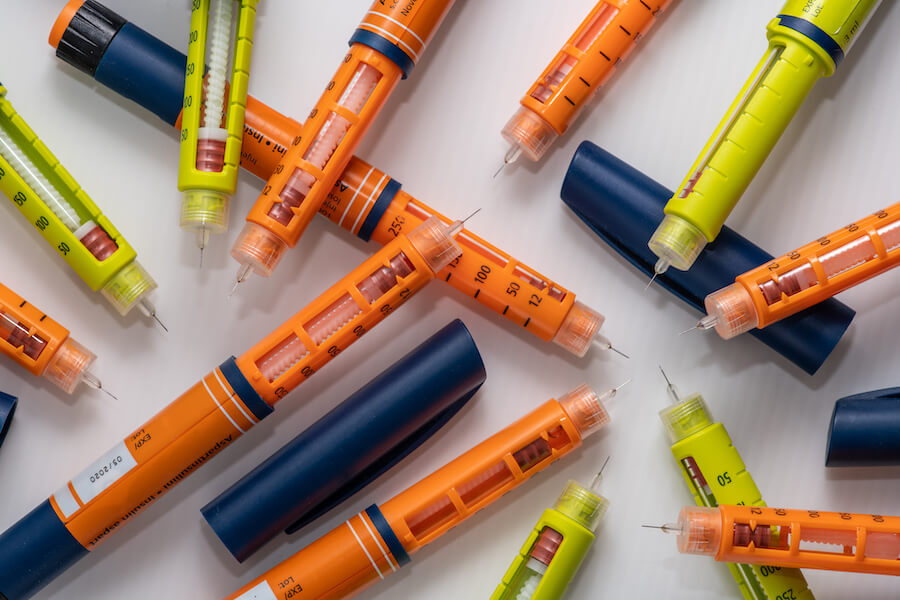Regulatory Affairs for Combination Products
The regulatory pathway and quality systems for combination products are complex and vary by region. When companies develop combination products, regulatory approval for both the pharmaceutical and device elements must be obtained and the quality systems must support both. RQM+ has the medical device expertise you need for combination products.
The regulatory process for combination products usually starts with a regulatory plan and strategy. Starting with designation by region, RQM+ subject matter experts will help you define the regulatory pathway to bring your product to market in the most efficient manner based on the claims being made. Our unrivaled collective knowledge at RQM+ can support your:
- Early stage or product change regulatory strategy
- US FDA Request for Designation (RFD) or Pre-RFD
- EU MDR classification challenges
- US FDA 510(k), PMA, De Novo, IDE, EUA, and device breakthrough or Device portions of ANDA, NDA, or BLA
- Navigation of EU MDR Article 117 requirements
Combination products regulated as drugs have design history file (DHF) requirements based on 21 CFR Part 4. In the EU, for an integral device you now must demonstrate compliance with the general safety and performance requirements (GSPR). RQM+ provides subject matter experts to assist with:
- DHF Remediation/creation
- Design Verification & Validation support
- Human Factors Use-related Risk Analysis (URRA) and/or threshold analysis
The MDR limited the definition of an integral device, requiring manufacturers to have CE marking for a device with an ancillary drug and/or Notified Body Opinion (NBOp) of a device integral to a drug. The GSPR component of the technical documentation is required for the NBOp, which ultimately requires supporting evidence just like standalone medical devices. This is new territory for pharmaceutical manufacturers. From strategy to tactical implementation, RQM+ brings the expertise to support:
- GSPR Gap assessment and/or remediation
- Notified Body Opinion (NBOp) for an integral device in a medicinal product
- CE Marking for a device used with a medicinal product
Combination products are subject to multiple regulations, including drug and device cGMP requirements, making your quality system requirements much more complex than with standalone pharmaceuticals. Additionally, there are device post-market reporting requirements that apply to combination products. We can assist with building your quality system to meet the requirements needed for each aspect of your combination product, from optimizing and ensuring compliance of your quality system to making sure your requirements cascade to your suppliers. With RQM+, you will be audit- and submission-ready, with our support:
- QMS gap assessments and/or remediation with 21 CFR part 4 requirements (see more detail about Quality System Regulations and Standards)
- Optimization of QMS for drug and device development processes
- Supplier audits to meet device supplier requirements (see more detail about Audits and Inspections)
- Complete outsourced solution for your post-market medical device reporting
Complex products come with complex regulatory requirements.
When you have a device constituent as part of your combination product, you need medical device regulatory expertise. That device will be reviewed by medical device experts at FDA and notified bodies even when it is submitted with your drug.
-

How RQM+ Delivers Value
For initial classification or request for designation (RFD), 510(k) submission, EU MDR certification, or device sections of your IND, NDA, or BLA, we act as a strategic partner to combination product manufacturers. RQM+ provides business value with expert resources who deliver full implementation from strategy through detailed tactical execution.
Whether you engage us for individual submissions, report writing, DHF remediation, or full outsourcing of your medical device regulatory and quality services, your organizational goals are our goals.
-
Combination Product Regulatory Pathway
With combination products, classification is not as straightforward as it is with pharmaceuticals or medical devices, and the required submissions vary by region. For example, in the US, combination products may be regulated primarily under the drug or device regulations based on the primary mode of action, although multiple FDA centers may be involved in the review. In the EU, combination products typically go through two submission channels—EMA and a notified body— and the device component of the product must also be classified based on the associated risk. If you have a drug in your device, it automatically becomes a Class III medical device in the EU. If you have a device in your drug, your pharmaceutical product requires a review by a notified body.
From the moment you start developing a new combination product, our team can help you determine the best regulatory path so that you are prepared for submissions when the time comes. If you are developing a new combination product, we can create a global regulatory strategy for your product.
-
Combination Product Quality Systems
RQM+ experts take you successfully from planning through implementation, ensuring your quality system works for your business and not the other way around. We develop a quality plan to properly scope your quality system to applicable regulations, a step that's essential to minimizing both cost and the burden on your resources.
Our quality assurance experts can take your existing 21 CFR 210/211 or 21 CFR 600-680 quality system and add the required device elements under 21 CFR Part 4 to cover medical devices. Additionally, we can assist with building in ISO 13485 requirements in your pharmaceutical quality system. Our dedicated global audit team can ensure your suppliers are scoped properly and compliant with applicable requirements. You can outsource audits to us as needed or hand off all of your suppliers to be managed by our turnkey supplier audit program.
Unrivaled Collective Knowledge
RQM+ team members at every level excel in their fields, but we don’t rely only on individual knowledge to deliver world-class regulatory consulting. We continue to develop our unrivaled collective knowledge through systems that ensure every industry insight and lesson learned permeates to every project. Seasoned combination product experts deliver the highest quality services to our clients.
Risk-Balanced Approach
RQM+ is your strategic partner. We help you align commercialization and regulatory strategies for your combination product with a balanced risk approach to support business objectives. We help you develop a risk-based quality system that meets combination product requirements by focusing on the processes that already work for your business, leveraging your strengths, and aligning those processes to the regulation rather than the other way around. This is the least disruptive and most sustainable path to having an effective quality system that is compliant to US and EU requirements for combination products.
Industry Insights
Our deep expertise comes from the sheer volume of work and collective expertise gathered across many combination product clients and many years of service. Additionally, key members of our team have extensive experience with combination product or are former FDA regulators and notified body leadership. This gives us unique insight into the expectations of reviewers so your combination product submissions will be prepared right the first time. This results in fewer questions, lower costs, and faster time to market.
Scalable Teams
Demands on your regulatory and quality teams have increased substantially as regulations for combination products have rolled out. RQM+ can add device expertise to your team at whatever level is required so you don’t have to worry about scaling your internal teams to meet short-term demands.
-
Combination Product Regulatory Compliance
Documentation and systems must be updated with evolving combination product regulations, post-market surveillance and reporting requirements, and product changes to keep up with state of the art and competition. The RQM+ team can develop strategies to align standards requirements between the US and EU to bring your products up to date, address any proactive remediation needs that arise, and develop effective processes to keep them compliant over the product lifecycle. Whether you need task-level support from combination product SMEs or full managed services led by our expert project managers, RQM+ has your back throughout the product lifecycle.
Learn more about Regulatory Compliance
What Our Clients Say
“With partners like you, I feel even more confident. I’m very appreciative of how you are presenting both short- and long-term solutions and speaking your ‘regulatory philosophy’ out loud.”
– Director, Clinical Compliance
Combination Products FAQs
What is the impact of adding a recognized drug to my device?
In the US, under the 510k process, it can be fairly straightforward on the submission side if you have a predicate that utilizes the same drug product at the same level. Adding an established drug that hasn’t been used in a device complicates the situation tremendously. It most likely will raise new questions of safety and performance leading to a de novo or PMA pathway. Adding a new chemical entity that functions as a drug will bring a consult from CDER on your device submission and all the testing to support the product just like a New Drug Application (NDA). In EU, the answer is that if the drug is ancillary to the device, you will leap all the way to a Class III device under Rule 14 and the drug substance dossier will be reviewed in addition to your full technical documentation package at the NB. Entering into the combination product world also means you will have to follow additional quality system regulations including 21 CFR 4 in the US.
I’m developing a combination product – do I need to submit a drug and a device application?
While some combination products can rely on a single application to gain regulatory approval, the simple answer is this – it depends! There are two main factors that impact this decision:
- The intended market – US and EU have key differences.
- The type of combination product – there are regulatory differences for single-entity/integral products, co-packaged products, or cross-labeled products
In the EU, Article 117 of the new EU MDR introduced new requirements for drugs with an integral medical device, which are equivalent to single-entity products in the US. Since 2021 the drug application will need to include a CE certificate for the device or include an opinion from a notified body on the conformity of the device if it is not CE marked. The notified body opinion could be obtained during the drug review if it is not separately CE Marked. Devices with an integral medicinal product are automatically classified as Class III medical devices and may require a drug review to achieve CE marking. Co-packaged products are treated differently in the EU and would typically require separate device and drug applications. Cross-labeled products align with the US in that CE marking is required separately from the drug application for these product types.
Should I use the Pre-Request for Designation (Pre-RFD) process or the Request for Designation (RFD) process to determine what will be the lead FDA Center assigned to review of my product?
The Pre-RFD process is used to get informal and non-binding feedback from the FDA about your combination product, whereas the RFD process provides binding feedback through a formal process. The Pre-RFD is helpful early in the product development stages where you may want to understand how the agency is likely to designate the lead center for reviewing your combination product - CDER, CBER, or CDRH. The pre-RFD process provides a flexible and approachable way to obtain informal feedback from the Agency about the type of marketing application and the lead FDA Center that is most likely to be assigned for review and regulation of the product. If you are in later stages of development and the device does not have a clear primary mode of action, then the formal RFD process provides a binding decision to assign the lead center for review. This process can be used to avoid rejection or delays in a marketing application if the classification or assignment is determined to be unclear or in dispute during the review process. It is important to note that a Pre-RFD or an RFD are not always required for a product. If the product is very similar to an existing product, then it is possible to rely on capsular decisions that are posted on the FDA website to understand how similar products have been assigned.
I have a legacy drug product that is considered a combination product in the US. Do I need to make any changes to my quality system to ensure I’m meeting the combination product regulations?
Yes, your drug quality system will need be adjusted to comply with additional device quality system requirements under 21 CFR 820 for management responsibility, design controls, purchasing controls, corrective and preventive action, installation, and servicing. While many of these elements may be covered in Pharmaceutical Quality Systems, design controls is one element that typically poses the most significant challenge for drug manufacturers. Design controls are a systematic process to ensure the product design meets the user needs, the intended uses, and any specific regulatory requirements. The design process culminates in a design history file, or a DHF, that is maintained over the product lifecycle. Drug manufacturers often need to adjust their quality systems to meet these requirements and also perform DHF remediation to ensure that changes in the product are appropriately documented over the lifecycle.
Tap into the RQM+ Knowledge Center.
GLOBAL BOTTOM CTA INSTRUCTIONS:
To display custom copy instead of global copy in this section, please go to Show Global Content for Bottom CTA? toggle in the "Contents" tab to the left, toggle it off, save, and then REFRESH the page editor, the custom text will then show up and ready to be edited.
Turning the global content back on will be the same process, go to the toggle and toggle it back on, save and refresh!




